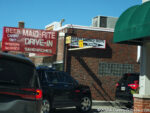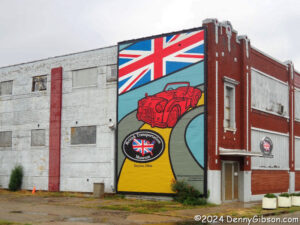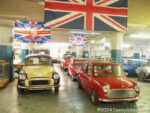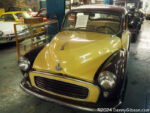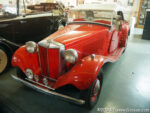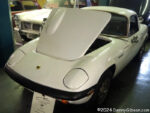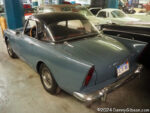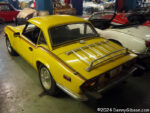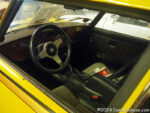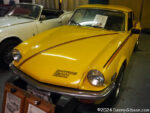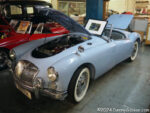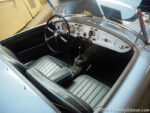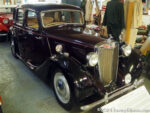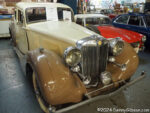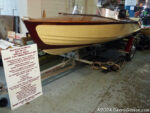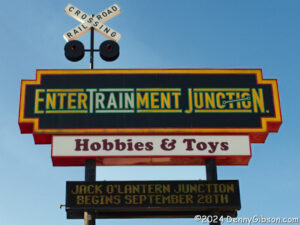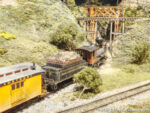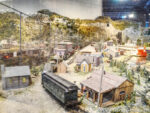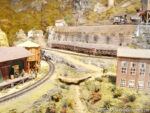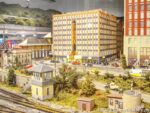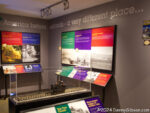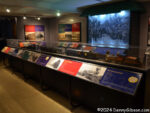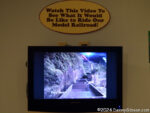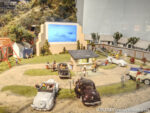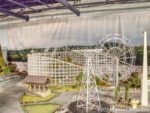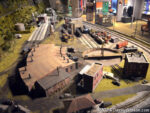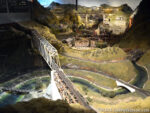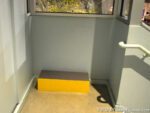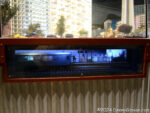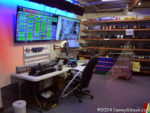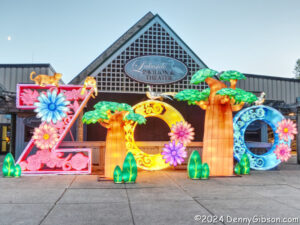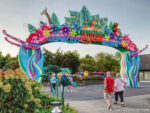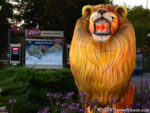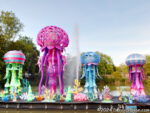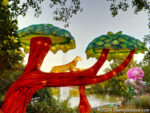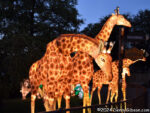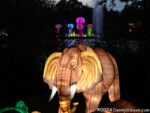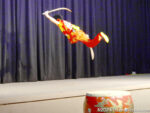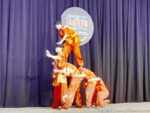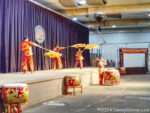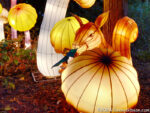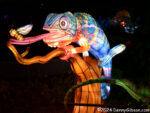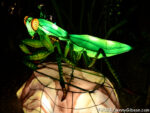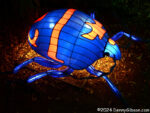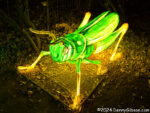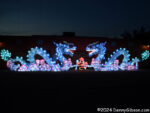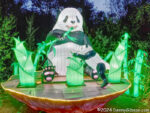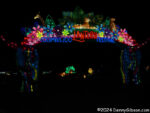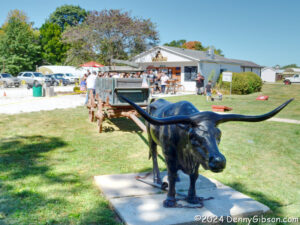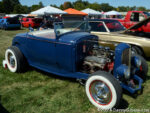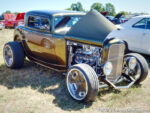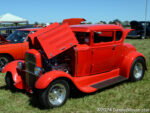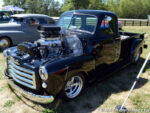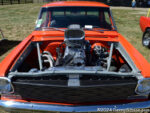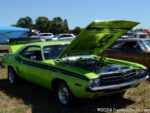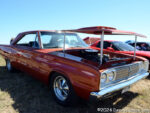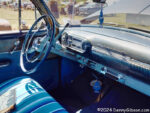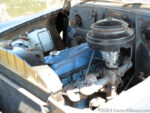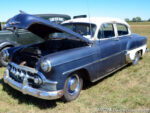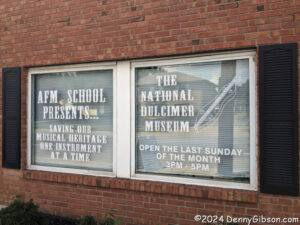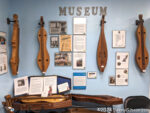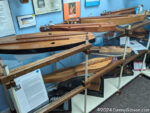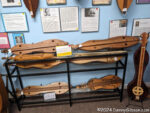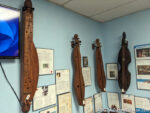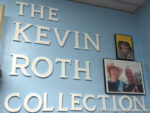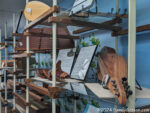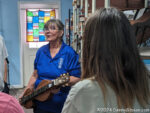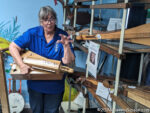 I believe I first heard of Hot Damn! It’s the Loveland Frog! about a year and a half ago when I was making plans to attend the inaugural Frogman Festival. It premiered at the 2014 Cincinnati Fringe Festival and had not been performed since. Resigned to accepting that I had missed what was likely my only chance of seeing it, the disappointment I felt last year probably made hearing that it would be performed this year even sweeter. I immediately reserved a seat in the front row for opening night.
I believe I first heard of Hot Damn! It’s the Loveland Frog! about a year and a half ago when I was making plans to attend the inaugural Frogman Festival. It premiered at the 2014 Cincinnati Fringe Festival and had not been performed since. Resigned to accepting that I had missed what was likely my only chance of seeing it, the disappointment I felt last year probably made hearing that it would be performed this year even sweeter. I immediately reserved a seat in the front row for opening night.
 That was last Thursday, and it was a hoot. It’s pretty obvious that the play’s writers, Mike Hall and Joshua Steele, realized something a decade ago that many residents of the city of Loveland have picked up on only recently: It doesn’t matter if it’s true or not, it’s fun.
That was last Thursday, and it was a hoot. It’s pretty obvious that the play’s writers, Mike Hall and Joshua Steele, realized something a decade ago that many residents of the city of Loveland have picked up on only recently: It doesn’t matter if it’s true or not, it’s fun.
 Nor does it matter if the music might not actually be, as promotional materials proclaim, bluegrass. The songs are good with lyrics that always help tell the story and are often quite funny. Almost every cast member sings and sings well. The four-piece band does a great job on every tune and may even sound a little bluegrassy in spots although it is done without the benefit of either banjo or mandolin. There is a fiddle, though, played by Linsey Rogers. She also plays “The Old Woman” who is also blind and often uses her bow like a cane. Tom Steele, Steve Goers, and Bill Jackson fill out the quartet on guitar, keys, and bass respectively.
Nor does it matter if the music might not actually be, as promotional materials proclaim, bluegrass. The songs are good with lyrics that always help tell the story and are often quite funny. Almost every cast member sings and sings well. The four-piece band does a great job on every tune and may even sound a little bluegrassy in spots although it is done without the benefit of either banjo or mandolin. There is a fiddle, though, played by Linsey Rogers. She also plays “The Old Woman” who is also blind and often uses her bow like a cane. Tom Steele, Steve Goers, and Bill Jackson fill out the quartet on guitar, keys, and bass respectively.
In addition to the scenic, and in this context unavoidable, Little Miami River, the script brings in other bits of Loveland such as the Loveland Castle, the Valentine Ladies, the popular bike trail, and the fact that Jerry Springer once called the city home. Just about every version of the Loveland Frog legend is referenced in one way or another and that includes a questionable Twightwee Indian tale presented with the aid of shadow puppets. There are characters in the play based loosely on individuals associated with the two most commonly mentioned “sightings” in 1955 and 1972. Maybe I did not need to include the word “loosely” there since every connection between something in the play and something in real life is a loose one.
Hall and Steele find lots of humor in those loose connections then thicken the laughter and the plot with some complete fiction. At the heart of the play are brother and sister moonshiners that take advantage of the frogman legend to scare folks away from an operation so successful that it has its own brand labeled Mason jars. A dishonest and disgraced cop and an ambitious college professor add to the confusion and laughter. The show’s sponsor, Schwartzman Taxidermy, benefits from surprise product placement and heartfelt endorsements. The whole show is funny but a canoe and bathtub chase on the river and a tandem bicycle trailed by a tiny scooter got me to laugh the hardest. Both of these scenes make good use of a moving projected background which plays a role in other scenes as well.
There have been a few attempts to make the Loveland Frog scarey but he is usually seen as rather harmless. That is how he appears here when he shows up near the play’s conclusion and, Wizard of Oz style, makes sure all ends well. Before leaving, he assures us that when a certain celestial alignment, which I did not have the wherewithal to record, occurs, he will be waiting at the bar in Paxton’s. I hope to be there and will happily spring for the first round of Ribbit River Moonshine.
 This is another of those reviews published too late to be useful. When I left home for Thursday’s show, several tickets remained for both the Friday and Saturday performances. I made plans to hurry home and ready the review for a Friday morning post to provide a little help in filling them. However, by the time I got home, Saturday was sold out and a single seat remained open for Friday. I could see that my help was not needed and aimed for the normal review publication day of Wednesday. That lone ticket was gone when I woke up Friday morning.
This is another of those reviews published too late to be useful. When I left home for Thursday’s show, several tickets remained for both the Friday and Saturday performances. I made plans to hurry home and ready the review for a Friday morning post to provide a little help in filling them. However, by the time I got home, Saturday was sold out and a single seat remained open for Friday. I could see that my help was not needed and aimed for the normal review publication day of Wednesday. That lone ticket was gone when I woke up Friday morning.
At the end of my post on that first Frogman Festival, I noted that I thought it looked successful, and wondered if there would be another. Despite a venue change and the main sponsor going out of business, there was, and dates for a 2025 event have already been set. I did not make this year’s event but Jacob the Carpetbagger did, and reported on it here.
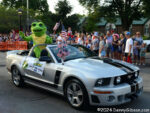 That 2023 Frogman Festival post also included a picture of Loveland’s rather new mascot taken earlier in the year at the city’s Hearts Afire event. At the time it seems not to have registered with me that part of the mascot’s job was to promote a new festival debuting in October of this year. It’s pretty obvious, however, in this picture taken during Loveland’s 2024 Independence Day Parade. The first Return of the Frogman festival will take place on October 12, 2024, with plans to have another “Leap into the Legend” every leap year going forward. The Loveland Stage Company will also be involved with a showing of Frogman, the movie, which was just released in March. Sadly, at the moment it looks like I won’t be here to attend the festival but I sure hope it’s a success. I guess if I can wait ten years to see the musical, I can wait four years for the festival and — maybe — the movie.
That 2023 Frogman Festival post also included a picture of Loveland’s rather new mascot taken earlier in the year at the city’s Hearts Afire event. At the time it seems not to have registered with me that part of the mascot’s job was to promote a new festival debuting in October of this year. It’s pretty obvious, however, in this picture taken during Loveland’s 2024 Independence Day Parade. The first Return of the Frogman festival will take place on October 12, 2024, with plans to have another “Leap into the Legend” every leap year going forward. The Loveland Stage Company will also be involved with a showing of Frogman, the movie, which was just released in March. Sadly, at the moment it looks like I won’t be here to attend the festival but I sure hope it’s a success. I guess if I can wait ten years to see the musical, I can wait four years for the festival and — maybe — the movie.
 This picture is from my 2012 Sixty-Six: E2E & F2F trip. Most of you will probably recognize Route 66 legend Angel Delgadillo standing behind me. This was my third end-to-end drive of Historic Route 66 and that is what the E2E in the title stands for. The F2F stands for “friend to friend”. This being my third full-length drive of the route, there were quite a few people along the way that I considered friends and to whom I could say hello. The Route 66 portion started with a Chicago tour conducted by the late David Clark with a Scott Piotrowski tour of Los Angeles at the other end. One purpose of the trip was to attend the Route 66 Festival in Victorville, CA, and I followed that with a visit with my son in San Diego then headed home through Tombstone, AZ, Roswell, NM, Gene Autry, OK, Hot Springs, AR, and several other interesting places.
This picture is from my 2012 Sixty-Six: E2E & F2F trip. Most of you will probably recognize Route 66 legend Angel Delgadillo standing behind me. This was my third end-to-end drive of Historic Route 66 and that is what the E2E in the title stands for. The F2F stands for “friend to friend”. This being my third full-length drive of the route, there were quite a few people along the way that I considered friends and to whom I could say hello. The Route 66 portion started with a Chicago tour conducted by the late David Clark with a Scott Piotrowski tour of Los Angeles at the other end. One purpose of the trip was to attend the Route 66 Festival in Victorville, CA, and I followed that with a visit with my son in San Diego then headed home through Tombstone, AZ, Roswell, NM, Gene Autry, OK, Hot Springs, AR, and several other interesting places.


 I first posted the core of this article in 2014. In the original title, I claimed to not care how anyone votes. That was never entirely true, of course. I have my favorite candidates and issues. I’ll be disappointed in anyone who votes differently than I do but not nearly as disappointed as I’ll be in anyone who doesn’t vote at all. I’m reminded of parents working on getting their kids to clean their plates with lines like, “There are hungry children in China who would love to have your green beans.” I’m not sure what the demand for leftover beans is in Beijing these days but I’m pretty sure some folks there would like to have our access to ballots and voting booths.
I first posted the core of this article in 2014. In the original title, I claimed to not care how anyone votes. That was never entirely true, of course. I have my favorite candidates and issues. I’ll be disappointed in anyone who votes differently than I do but not nearly as disappointed as I’ll be in anyone who doesn’t vote at all. I’m reminded of parents working on getting their kids to clean their plates with lines like, “There are hungry children in China who would love to have your green beans.” I’m not sure what the demand for leftover beans is in Beijing these days but I’m pretty sure some folks there would like to have our access to ballots and voting booths.